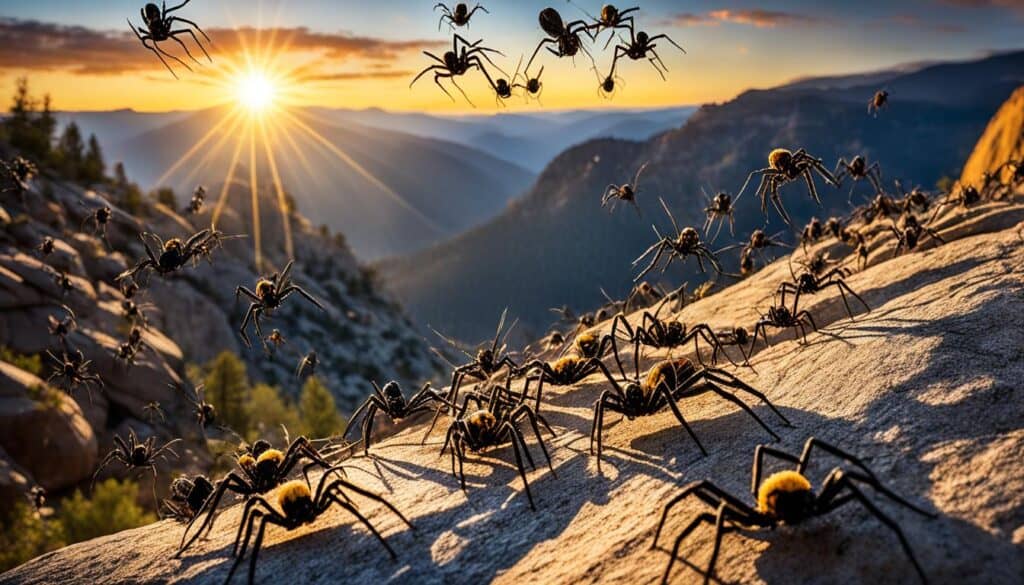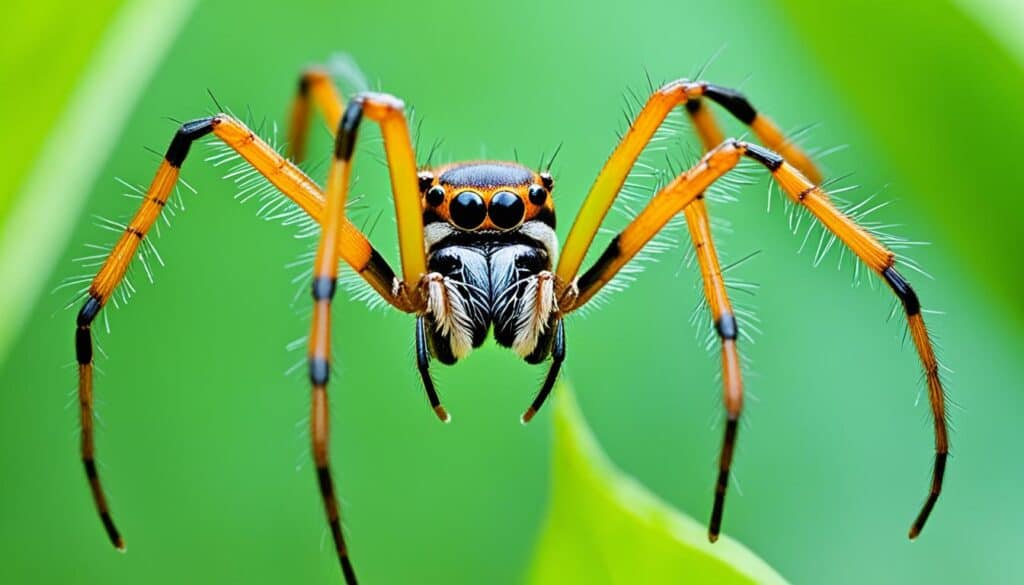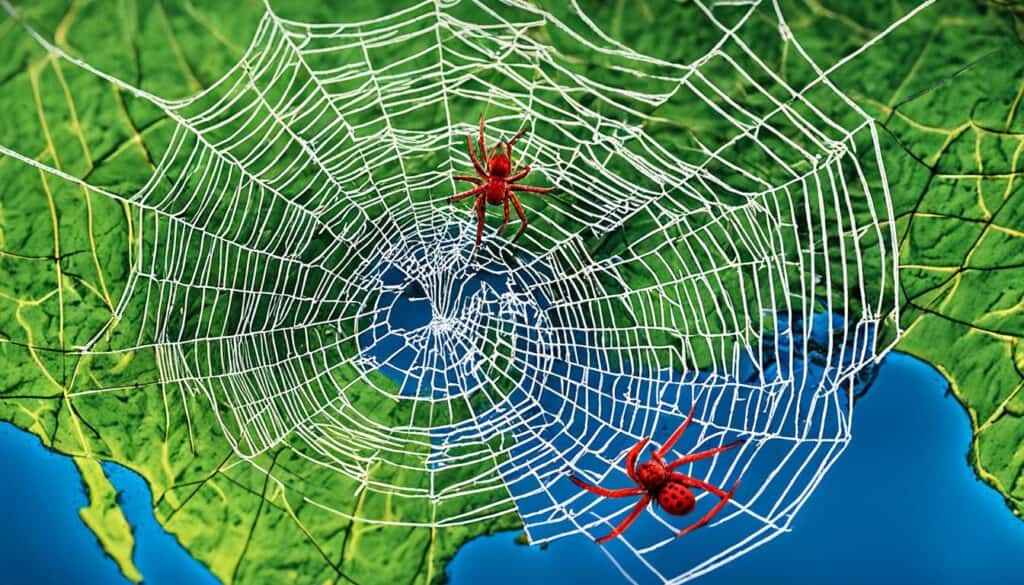Joro spiders have heart rates that go up by 77% in the cold. It’s like they’re in a marathon, while we just want to keep warm. These spiders are from East Asia but now live in the southeastern U.S. Experts think they might spread to the East Coast because of their cold survival skills and unique way of moving.
These colorful spiders came to the U.S. in 2013, probably on ships from Japan. They spread quickly. They’re not harmful and even help by being food for native birds. Their way of moving around, and accidentally getting help from people, has made them spread. But, they might not be as scary as we thought.
Key Takeaways
- Joro spiders are spreading along the Eastern Seaboard, adapting to colder climates.
- They boast a significantly faster metabolism and heart rate in low temperatures.
- These spiders arrived in the U.S. around 2013, likely via shipping containers.
- Despite their intimidating looks, they’re harmless to humans and pets.
- Researchers encourage reporting sightings and learning to coexist without excessive pesticide use.
Stay tuned to learn how these spiders are quickly moving across states. Find out what this means for their new areas.
The Great Migration: Joro Spiders Moving Into New Territories
The Joro spider made its way across Georgia and the Southeast since landing in the U.S. in 2013. They quickly became a hot topic with their ability to move around and adapt to new climates. Everyone is talking about these spiders.
Why are they spreading so fast? One reason is their high metabolism and heart rate, which is 77% higher than their cousins’. It’s like comparing a hyper squirrel to a chill one. Thanks to this, Joros can handle colder places, which helps them move beyond the warm Southeast.
The Joro spiders also travel by ballooning. That means they float on the wind to new areas. Plus, people unknowingly help them move by taking them along on vehicles and ships. These spiders have turned into global explorers.
Reports show these spiders popping up in places like Oklahoma! This is a sign of their expanding territory. Their ability to adapt and live in new places is amazing. It shows how they’ve also spread across Japan, which has a climate similar to the U.S.
As these spiders keep moving and claiming new areas, stay alert. You might spot a Joro spider floating by in the air. They spread through natural migration and with our help, aiming to cast their webs across new lands.
Joro Spider Identification: Spotting the Spindle-Legged Invaders
Alright, spider-spotters, grab your binoculars! We’re diving into Joro spider identification, focusing on key features. Imagine a large spider, bright and bold, with long, skinny legs. Its colors? Blue-black and yellow stripes. It looks like something out of a superhero film, thanks to its striking appearance.
These spiders are hard to miss with their big, yellow-striped bodies. They even have a flashy red spot underneath. Their bodies can grow up to 3 inches long. Spotting one in its golden silk web is unmistakable—they spin beautiful, golden webs. Just don’t confuse them with common yellow garden spiders.
Mixing up spiders is just one thing to avoid. Think twice before using pesticides on these spiders. Chemicals can harm more than just pests. These spiders might just be harmless guests in your garden.
Joro Spider in Different Regions
Have you noticed more spiders around lately? Meet the Joro spider, an invasive guest from abroad. It arrived in Georgia in 2013. Since then, it has spread through the Southeast. Researchers at the University of Georgia believe it could reach further along the East Coast.
Why do Joro spiders spread so much? They’re almost like superhero spiders. They have twice the metabolism and a heart rate 77% higher than the golden silk spider. They can also survive short freezes, making them fit for colder areas.
In Japan, Joro spiders are everywhere due to the climate. This suggests they might do the same on the East Coast. Human actions help them move. They hitch rides on goods and use winds to travel on silk threads. This makes them nearly unstoppable.
Seeing Joro spiders might not be as bad as it seems. They’re more annoying than dangerous. Their bites are seldom harmful. But as they spread, it’s critical to keep studying them. This helps us know their effects on the environment and local wildlife.
Impacts of Joro Spiders on Local Ecosystems
The Joro spider arrived in the U.S. in 2013 and has been exploring the Southeast since. Known for traveling, the real question is how they affect our ecosystems.
Researchers worry these spiders could be a problem for native ones. Joros are much faster, with double the metabolism and 77% higher heart rates. So, they could out-compete local spiders for food and space.
However, there are possible good sides too. The University of Georgia found that Joros eat harmful stink bugs and mosquitoes. They’re unexpectedly fighting off pests that damage crops.
But, it’s not all good news. These spiders may also catch bees in their big webs. Early studies show they might trap bees, which are important pollinators. More research is needed to understand these effects better.
It’s still unclear if Joro spiders are good or bad for the environment. Continued research and help from citizen scientists are revealing more about their role. The story of these spiders and their impact is ongoing.
My Life with Joro Spiders: A Tale from New Jersey
Living in New Jersey means seeing beautiful scenes and sometimes spiders. Yet, Joro spiders in my yard have been a standout. These spiders, with their bright yellow and grey colors and wide leg span, are incredible and a little bit scary.
One sunny day, I saw my first Joro spider during garden work. Its huge web and unique colors surprised me. I felt amazed yet uneasy. I soon found out these spiders don’t harm humans. Their venom is for catching insects.
These encounters changed how I spend time outdoors. When I see a Joro spider, it’s like finding a piece of Asia in New Jersey. They may travel in shipping containers or use silk strands to fly on the wind.
Studying these spiders showed me how invasive species affect our area. Their big webs, which can be 10 feet wide, are now a common sight. This has made me talk more with my neighbors. They wonder if these spiders could be dangerous. Yet, experts say they’re mostly harmless to us and our pets.
Invasive creatures like the Joro spider are interesting. We don’t know how they’ll impact New Jersey’s environment in the long run. But seeing them has made gardening more exciting and surprising for me.
Public Interaction with Joro Spiders: Handling The Hysteria
Imagine you’re in your backyard, enjoying your coffee. Suddenly, you see a spider as big as a small pizza above you. Don’t panic—it’s just a Joro spider doing its thing! People react differently to these spiders, from fear to interest. So, what’s the best way to deal with the hysteria surrounding Joro spiders?
First off, Joro spiders can be as big as three inches across. But remember, their venom won’t hurt humans much. If they do bite, it’s only a minor irritation. It’s key to remember they start tiny, like a grain of rice, so the giant ones are rare.
Joro spider sightings are getting more common as they move around. They were first spotted in Atlanta, but now they’re in the Carolinas and southeastern Tennessee too. There’s even a group in Baltimore now. They might reach the Northeast soon, but who knows when.
Read more about Joro spiders and their spread.
Now, let’s clear up some myths about invasive species. Joro spiders aren’t trying to take over. They eat insects in their webs, which helps control pests like stink bugs and mosquitoes. Teaching people about these perks helps reduce fear and creates a more positive view.
Learning about spiders isn’t just about cool facts, like how baby Joros fly through the air. It’s about understanding their harmless nature and role in nature. With the right facts, we can shift from fear to maybe even liking them, or at least not minding them.
Conclusion
Our journey with the Joro spiders shows they love to travel. They first appeared in Georgia in 2014. Now, they’ve spread across four states and showed up in four more. They really get around!
These spiders move by “ballooning,” which sounds pretty cool. Think of them as tiny adventurers gliding on the wind. They live in both cities and the countryside. But their big webs are causing problems for local wildlife.
People have mixed feelings about Joro spiders. Some don’t want them around. But experts recommend using a broom, not pesticides. We’re learning they might help by eating pests. It looks like we need to watch, adapt, and even laugh as we get used to them.




